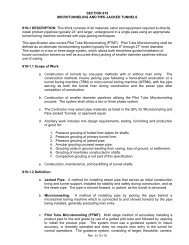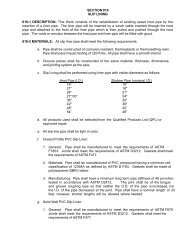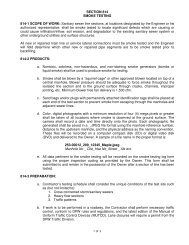Contents
Construction Management Plan - Baton Rouge Department of Public ...
Construction Management Plan - Baton Rouge Department of Public ...
- No tags were found...
Create successful ePaper yourself
Turn your PDF publications into a flip-book with our unique Google optimized e-Paper software.
o<br />
Reapply repellants before the duration of protection expires:<br />
DEET Concentration Hours of Protection<br />
5-10% 2-4 hours<br />
15% 6 hours<br />
25-30% up to 8 hours<br />
100% 10+ hours<br />
Tick Check<br />
A tick check should be performed after field activities in potential tick habitats, before entering the<br />
field vehicle (you do not want to infest your field vehicle with ticks). Have your field partner check<br />
your back; the backs of your legs, arms and neck; and your hairline. Shake off clothing as<br />
thoroughly as possible before entering the vehicle. Once the field day is completed, repeat this<br />
procedure and perform a thorough self-check.<br />
At the end of the day, search your entire body carefully for ticks, (particularly the groin, armpits,<br />
neck and head), and shower.<br />
Tick Removal<br />
If a tick has embedded itself into the skin, remove the tick as described below. Before performing<br />
activities in potential tick habitats, obtain a Tick Removal Kit from the<br />
regional warehouse (contact Kevin Mayer/GNV, 352-237-8199). The tick<br />
must be removed quickly, cleanly and intact:<br />
• The tick must be removed quickly, the sooner it is removed the less<br />
likely the transmission of potentially infectious organisms, if it is<br />
carrying them.<br />
• The tick must be removed cleanly, to prevent the bite wound form becoming infected.<br />
• The tick must be removed intact, to prevent infecting the ticks fluids into the bite wound which<br />
may contain infectious organisms. Also if intact, the tick may be assessed to determine if it is<br />
carrying infectious organisms (see procedures below).<br />
1. Use pointed, precision tweezers. Cosmetic tweezers with wide, flat ends may crush the tick,<br />
increase the potential of the transmission of potentially infectious organisms if the tick is<br />
carrying them, and make the wound worse. Choose unrasped fine-pointed tweezers whose tips<br />
align tightly when pressed firmly together.<br />
2. After disinfecting the area first, grasp the tick as close to the skin surface as possible and pull<br />
upward with stead, even pressure.<br />
• Do not twist or jerk the tick, this may cause the mouth parts to break off and remain in<br />
the skin. If this happens, remove mouthparts with tweezers, and consult your<br />
healthcare provider if infection occurs.<br />
• Do not grasp, squeeze, crush, or puncture the body of the tick because its fluids (saliva,<br />
hemolymph, gut contents) may contain infectious organisms. Releasing these<br />
organisms to the outside of the tick’s body or into the bite area may increase the chance<br />
of infectious organism transmission.<br />
• Do not handle the tick with bare hands because infectious agents may enter through<br />
mucous membranes or breaks in the skin.<br />
3. Place tick in a zip lock bag.<br />
A-36 GNV310133632156.DOC/090840008












